AustLit
Latest Issues
AbstractHistoryArchive Description
Launched in 1908 as an all-fiction offshoot of the general-interest magazine, The Scrap Book (1906-1911), The Cavalier ran for just 163 issues but nevertheless played a significant part the development of the pulp magazine industry. Originally published on fine book paper with refined, 'classy' covers, the Munsey company changed its format to pulp paper in 1909, and from 1911 onwards included in-text illustrations. The magazine also traded in its sophisticated covers for more exciting, colorful images of adventure.
In January 1912, The Cavalier absorbed its predecessor, The Scrap Book, and became the first weekly pulp. It also temporarily adopted the name The Cavalier and The Scrap Book. Although the magazine effectively folded in May 1914 when Munsey's merged it with The All-Story, the new venture was known for aaabout a year as All-Story Cavalier Weekly.
[Source: The Pulp Magazine Project]
Publication Details of Only Known VersionEarliest 2 Known Versions of
Has serialised
-
The Spotted Panther,
single work
novel
A fifteenth century Portugese culture is discovered in Borneo.
-
The White Waterfall,
single work
novel
adventure
horror
A treasure is found by a party of adventurerers among the ruins of a once-great civilisation on a remote, isolated South Sea island. The structures that pre-date the memory of any race that left written records. Although the island is thought to be uninhabited the party comes across a small community of natives who perform ceremonies and make human sacrifices in the name of some savage God. The terrors they discover in the depths of the jungle are all too human, however:
'The protagonist, and narrator, Jack Verslun, an itinerant seaman, is hired to serve on a ship chartered by Professor Herndon, an obsessive scientist who has brought along his two attractive daughters on what turns out to be an ill-advised and dangerous voyage to “The Isle of Tears,” which a rough-looking rogue named Leith has promised the Professor will yield scientific wonders that will make his reputation. The party, aside from a largely native crew, is completed by Will Holman, a feisty young American who — the son of the owner of the chartered boat they are traveling on — is along for the heck of it and for the love of the younger of the two Herndon girls, Barbara. An older daughter, Edith, is useful for completing a quartet that I needn’t spell out for you. They reach the island after a terrific storm and when Jack is ordered to stay on the boat while Leith takes a small party to the island, concerned about Leith’s intentions, he jumps ship, catches up with the party and finds himself, Will, and the Professor and his daughters, in a situation that takes them to the brink of disaster' (Walter Albert, Mystery*File 28 February 2010).




